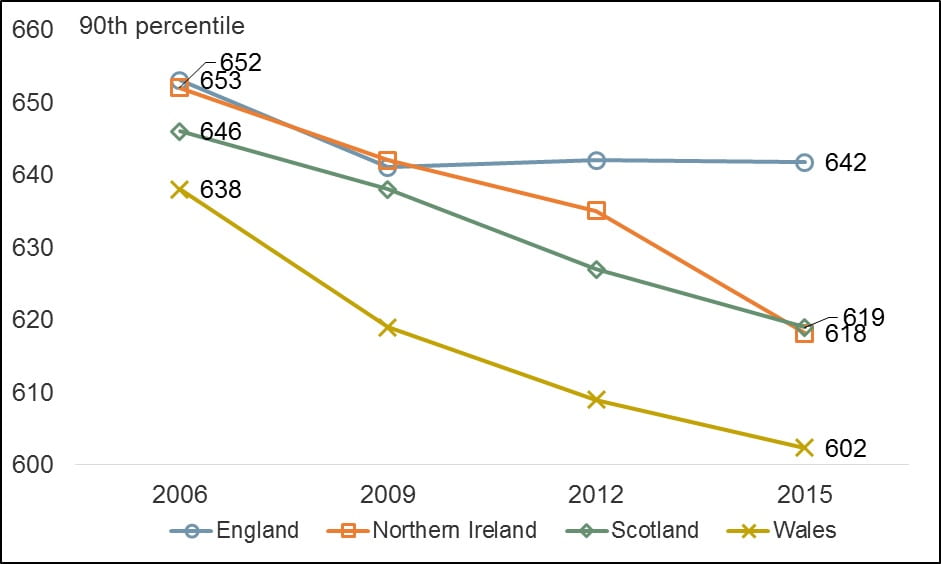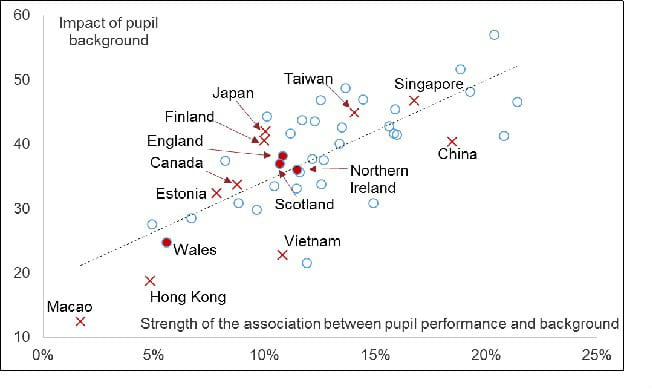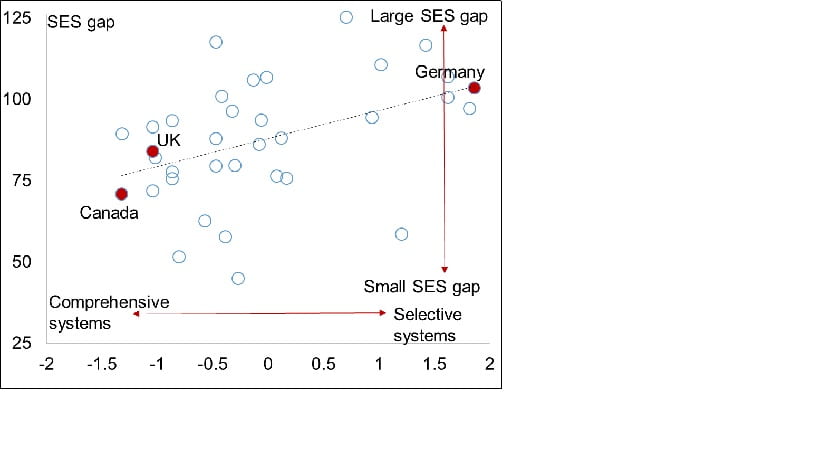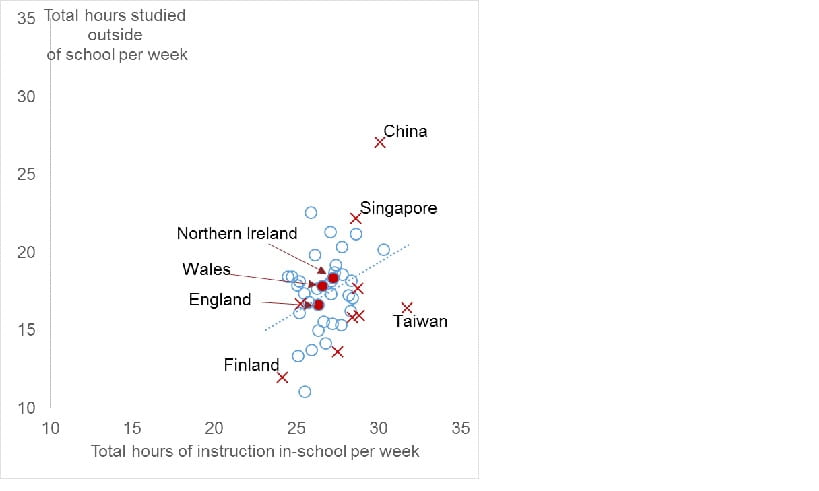The ten key findings from PISA 2015
By Blog Editor, IOE Digital, on 6 December 2016
John Jerrim.
Today, the Organisation for Economic Co-Operation and Development (OECD) release results from the 2015 round of the Programme for International Student Assessment (PISA). Although the ‘country rankings’ take the headlines, there are many other (and often more interesting) findings once you scratch below the surface. In this blog2post, I provide a crash-course in ten other key findings for the UK from the latest wave of PISA data. For further details on any of these results, see the PISA 2015 national reports for England, Wales and Northern Ireland that I have co-authored.
1. Although average scores have remained stable in the UK, this masks some notable differences between the four countries over the last decade…
There has been no significant change in England’s average PISA score, in any subject, since 2006 (the first time point to which we can compare). However, average science scores have fallen by around 20 test points (two terms of schooling) in Wales, with a similar decline in mathematics scores between 2006 and 2015 in Scotland.
2. …but we shouldn’t (yet) read too much into the fall in science scores between 2012 and 2015
Undoubtedly, education in Scotland is likely to come under the microscope today, in part because of the pronounced decline in its 15-year-olds’ PISA science scores over a short period of time. As the graph below illustrates, there has been a sudden fall in science scores in Scotland. However, as the experience of the Republic of Ireland taught us in 2009, this may simply be a blip in performance before a return to normality in the next round. There is not yet a clear trend emerging in Scotland, at least for science, and we should all be cautious before jumping to too strong a conclusion.
Figure 1. Average PISA science scores since 2006

3. England has some of the best young scientists anywhere in the world and our pupils think science is important for their future
When we focus upon the top 10 per cent of pupils in science, England is amongst the world’s leading countries. In only three countries (Singapore, Taiwan and Japan) are the top 10 per cent of pupils more than a school term ahead of the top 10 per cent of pupils in England (in science). In contrast, there are more than 50 countries where the highest-achieving pupils are more than a term of schooling behind the highest-achieving pupils in England.
More than a quarter of pupils (28 per cent) in England hope to be working in a science related career by age 30, which is above the average across the high-performing countries (22%) and almost double the proportion in 2006 (16%) – the (joint) highest increase internationally over this period
4. Yet, in other parts of the UK, the performance of the highest-achieving pupils in science has declined markedly over the last decade
As the chart below illustrates, there have been significant falls in the science performance of the most able pupils in Northern Ireland, Scotland and Wales since 2006. In each of these countries, the fall since 2006 has been around 30 PISA test points (one year of schooling) and sometimes more. In contrast, the trend in science scores for high-achieving pupils in England has remained broadly flat.
Figure 2. The 90th percentile of PISA science scores since 2006
5. In contrast to widespread belief, socio-economic differences in pupils’ performance are no more pronounced in England than in other countries.
Although the gap between England’s highest and lowest achieving pupils is reasonably large compared to other countries, this does not neccesarily mean that socio-economic differences in 15-year-olds’ science skills are greater in this country than elsewhere. In fact, the graph below illustrates how the association between family background and PISA performance in England is actually very similar to the situation in most other countries. Indeed, the relationship between family background and performance is very similar in England to Finland – a country frequently lauded for being comparatively equitable. The chart also reveals that there are stark levels of socio-economic inequality in some high-performing countries (e.g. Taiwan, Singapore and China) but not in others (e.g. Canada, Estonia and Hong Kong).
Figure 3. The link between family background and pupils’ PISA science scores

6. Family background has a much weaker impact upon pupils’ PISA scores in Wales than in the rest of the UK…
In fact, according to PISA, Wales is actually one of the most equitable countries (in terms of educational outcomes) anywhere in the world.
However, this may not be the good news story that it first seems. As demonstrated by the chart below, this result is being driven by the comparatively low scores in Wales of the most advantaged socio-economic group. Fifteen-year-olds from the most advantaged family backgrounds in Wales are lagging behind high socio-economic status pupils in the rest of the UK and, indeed, most other industrialised countries.
Figure 4. Average PISA science scores by socio-economic group across the UK

7. Grammar school pupils in England perform particularly well in PISA…
… so well that, in science and mathematics, they actually achieve higher scores than pupils in independent schools. In fact, with an average PISA science score of 595, grammar school pupils in England are amongst the best young scientists anywhere in the world. Of course, these figures do not provide any evidence as to whether grammar schools are more effective than other school types, as differences in the demographic characteristics of pupils and their prior achievement has not been taken into account. Also, the independent group includes a mix of both selective and non-selective schools. Nevertheless, Table 1 illustrates how grammar school pupils in England have academic skills ahead of the average 15-year-old in many of the highest achieving PISA countries.
Table 1. Average PISA science scores by admissions policy in England
| Science | Maths | Reading | |
| Comprehensive | 502* | 483* | 490* |
| Independent (selective and non-selective) | 566* | 548* | 555 |
| Selective (grammar) | 595 | 573 | 571 |
Note: * indicates significantly below the selective group at the five per cent level. Figures are unconditional and do not control for differences in demographic characteristics of pupils or their prior achievement.
8. There is no evidence from PISA that countries with academically selective schooling systems have smaller gaps between the highest and lowest socio-economic groups
Rather, as the chart below illustrates, the opposite may hold true. The gap in science performance between pupils from the most and least advantaged 25 per cent of families is actually slightly bigger in those countries where academic selection is used to decide entry into secondary schools.
Figure 5. The academic selectivity of secondary schooling systems and the gap in science performance between socio-economically advantaged and disadvantaged pupils

9. Headteachers in England see teacher supply as a key barrier to providing more effective instruction…
….with 45 per cent reporting this to be a problem, compared to around 30 per cent of teachers in the average industrialised or high-performing country. On the other hand, headteachers in England are less likely to report that their staff are resistant to change than headteachers in the average OECD country (17 per cent versus 30 per cent) and are generally positive about the resources that are available to teach science within their school.
Table 2. Headteachers’ views on the factors hindering instruction within their school
| England | OECD | H10+ | |
| A lack of teaching staff | 45% | 29%* | 31%* |
| Inadequate or poorly qualified teachers | 22% | 20% | 26% |
| A lack of assisting staff | 18% | 36%* | 33%* |
| Inadequate or poorly qualified assisting staff | 12% | 19%* | 20%* |
| A lack of educational material | 29% | 34% | 32% |
| Inadequate or poor quality educational material | 26% | 30% | 30% |
| A lack of physical infrastructure | 48% | 36%* | 37%* |
| Inadequate or poor quality physical infrastructure | 45% | 35%* | 35%* |
| England | OECD | H10+ | |
| Teachers not meeting individual pupils’ needs | 30% | 23% | 31% |
| Teacher absenteeism | 24% | 17% | 14%* |
| Staff resisting change | 17% | 30%* | 32%* |
| Teachers being too strict with pupils | 5% | 13%* | 16%* |
| Teachers not being well prepared for classes | 11% | 12% | 19%* |
10. Children in China and Singapore put in a lot of hours studying…
… and many more than pupils in England, Wales and Northern Ireland; particularly in additional study outside of school. However, as the chart below illustrates, there are several other high-performing countries where this is not the case. For instance, despite Finland’s relatively high PISA scores, Finnish pupils report amongst the lowest study hours of any country anywhere in the world (both inside and outside of school). Yet there are also outliers, such as Taiwan, where pupils report spending the same amount of time studying outside of school as pupils in England, but more hours inside of school.
Figure 6. Average study hours reported by pupils across all subject areas

5 Responses to “The ten key findings from PISA 2015”
- 1
-
2
educationstate wrote on 7 December 2016:
If schools in the samples self-select, PISA is fundamentally flawed. If a test does not tell teachers about how individual learners fared, it is useless.
-
3
Why grammar schools are no quick fix for England’s social mobility problems | British Politics and Policy at LSE wrote on 14 December 2016:

[…] the opposite may be true. As figure 2 demonstrates, selective systems are also shown to have bigger gaps between rich and poor pupils and thus greater inequality. The overall report concludes that all types of pupils benefit from […]
-
4
What the PISA scores have taught us | Twig Education wrote on 11 September 2017:

[…] in science. When we focus upon the top 10 per cent of pupils in science, the UK is amongst the world’s leading countries. England has some of the best young scientists anywhere in the world, and pupils think science is […]
-
5
What the PISA scores have taught us – Twig Education wrote on 30 January 2019:

[…] in science. When we focus upon the top 10 per cent of pupils in science, the UK is amongst the world’s leading countries. England has some of the best young scientists anywhere in the world, and pupils think science is […]
 Close
Close




Excellent summation as ever.